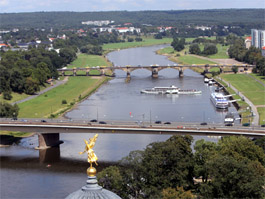
UNESCO removed Dresden from the World Heritage List
 |
According to the committee, the bridge being built will irrevocably divide the nearly 20-kilometer-long Elbe Valley and destroy its cultural landscape. Of the 21 countries represented on the committee, 14 members voted for the removal, five were against, and two votes were invalid. Germany currently does not have a representative on the committee.
German Cultural Minister Bernd Neumann expressed regret over Dresden's removal from the prestigious list and lamented that the two sides were unable to reach a compromise. "Despite this regrettable development, I advise everyone to remain calm," he tempered the emotions that today’s UNESCO decision may provoke in Germany. The western neighbor of the Czech Republic had 33 sites on the list until now.
The valley was listed in 2004, but just two years later, UNESCO placed it among endangered sites. Last year, the organization issued an ultimatum to the Saxon metropolis, stating that it would completely remove the unique set of natural and architectural monuments along the banks of the Elbe from the prestigious list if Dresden did not stop the construction of the bridge near the Forest Castle. As an alternative, UNESCO repeatedly recommended that instead of the bridge a tunnel be constructed. However, the city rejected this, citing higher costs and ecological damage that the tunnel excavation would entail.
According to the city hall in Dresden, the bridge over the Elbe near the Forest Castle is necessary to relieve traffic in the overloaded historic center, which is also protected as a monument. To meet the requests of the world organization, the city at least prepared a project for a streamlined version instead of the original massive bridge.
Construction of the more than 600-meter-long bridge began two years ago and is expected to be completed in 2011. The costs were estimated at 156 million euros (over four billion czk), of which 37 million has already been spent. Residents of the Saxon metropolis voted for the construction in a 2005 referendum, which is binding for the city authorities. German courts have previously confirmed that the construction of the bridge is legal.
In the entire existence of the World Heritage List, this is only the second time a site has been removed. The first time this happened was in 2007 in the case of Oman, whose government allowed a drastic reduction of the reserve where the endangered Arabian oryx lives.
The Omani reserve was registered as a natural monument, while Dresden was classified by UNESCO as a cultural heritage site. Therefore, the Elbe Valley is the very first cultural monument to be removed from the list. A removed monument cannot return to the list, which currently has 878 entries. After today, UNESCO still lists 29 endangered sites.
The English translation is powered by AI tool. Switch to Czech to view the original text source.
0 comments
add comment






